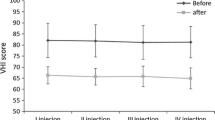Abstract
The authors describe the case history of a patient who suffered from symptoms deriving from two different origins. The patient's voice was spasmodic dysphonia-like interrupted and pressed. At the same time, his voice was powerless, too. The reason for this was that besides the spasmodic dysphonia caused by hyperkinesis, an incomplete closure of the vocal cords during phonation in the middle third was present. It was caused by the atrophy of the vocal cords. In order to eliminate the symptoms, initially we injected 25 IU Botox into the left vocal cord transcutaneously under the direction of EMG control. It resulted in a fluent, though breathy voice. In order to manage the closing insufficiency during phonation, we performed lipoaugmentation on the left vocal cord under high-frequency jet anaesthesia. The result of the two-step procedure was a fluent and clear voice. The speech without interruption lasted for 5 months, until the drug was eliminated. Of course, to prolong the result, the Botox injection should be repeated.


Similar content being viewed by others
References
Dedo HH (1976) Recurrent nerve section for ASD. Ann Otol Rhinol Laryngol 85: 451–459
Berke GS, Blackwell KE, Gerratt BR, Verneil A, Jackson KS, Sercarz JA (1999) Selective laryngeal adductor denevation-reinnervation: a new surgical treatment for ASD. Ann Otol Rhinol Laryngol 108: 227–231
Fritzell B, Feuer E, Haglund S, Knutsson E, Schiratzki H (1982) Experiences with recurrent laryngeal nerve section for spastic dysphonia. Folia Fonatr (Basel) 34: 160–167
Blitzer A, Brin MF, Fahn S, Lange D, Lovelace RE (1986) Botulinum toxin for the treatment of ASD. Laryngoscope 96: 1300–1301
Ludlow CL (1990) Treatment of speech and voice disorders with botulinum toxin. JAMA 264: 2671–2675
Jankovic J, Brin MF (1991) Therapeutic uses of botulinum toxin. N Engl J Med 324: 1186–1194
Wendler J, Seidner W, Kittel G, Eysholdt U (1996) Lehrbuch der Phoniatrie und Paedaudiologie. Thieme, Stuttgart, New York, pp 118–125
Hacki T (1999) Tonhöhen-und Intensitaetbefunde bei Stimmgeübten. Vergleichende Sprechstimmfeld-, Rufststimmfeld- und Singstimmfeldmessung. HNO 47: 809–815
Friedrich G (1998) Externe Stimmlippenmedialisation: Funktionelle Ertgebnisse. Laryngo Rhino Otol 77: 18–26
Author information
Authors and Affiliations
Corresponding author
Additional information
This paper was presented at the 4th ELS Congress in Brussels, 5–7 September 2002.
Rights and permissions
About this article
Cite this article
Kaszás, Z., Lichtenberger, G., Mészáros, K. et al. Spasmodic dysphonia combined with insufficient glottic closure by phonation. Eur Arch Otorhinolaryngol 260, 418–420 (2003). https://doi.org/10.1007/s00405-003-0604-0
Received:
Accepted:
Published:
Issue Date:
DOI: https://doi.org/10.1007/s00405-003-0604-0




